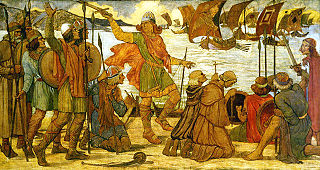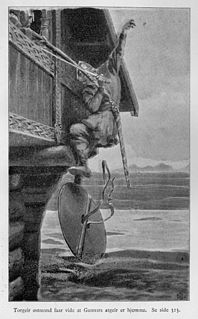Related Research Articles

A polearm or pole weapon is a close combat weapon in which the main fighting part of the weapon is fitted to the end of a long shaft, typically of wood, thereby extending the user's effective range and striking power. Polearms are predominantly melee weapons, with a subclass of spear-like designs fit for both thrusting and throwing. Because many polearms were adapted from agricultural implements or other fairly abundant tools, and contained relatively little metal, they were cheap to make and readily available. When warfare would break out and the belligerents had a poorer class who could not pay for dedicated military weapons, leaders would often appropriate tools as cheap weapons. The cost of training was comparatively minimal, since these conscripted farmers had spent most of their lives using these "weapons" in the fields. This made polearms the favored weapon of peasant levies and peasant rebellions the world over.

Eric Haraldsson, nicknamed Eric Bloodaxe, also known as Eirik fratrum interfector was a 10th-century Norwegian ruler. It is widely speculated that he had short-lived terms as King of Norway and twice as King of Northumbria.

Svealand, Swealand is the historical core region of Sweden. It is located in south central Sweden and is one of three historical lands of Sweden, bounded to the north by Norrland and to the south by Götaland. Deep forests, Tiveden, Tylöskog, and Kolmården, separated Svealand from Götaland. Historically, its inhabitants were called Svear, from which is derived the English 'Swedes'.
Grímr Kveldúlfsson, usually called Skalla-Grímr, was a Norwegian who lived in the ninth and tenth centuries. He is an important character in Egils saga and is mentioned in the Landnámabók.

Hålogaland was the northernmost of the Norwegian provinces in the medieval Norse sagas. In the early Viking Age, before Harald Fairhair, Hålogaland was a kingdom extending between the Namdalen valley in Trøndelag county and the Lyngen fjord in Troms og Finnmark county.

Knowledge about military technology of the Viking Age is based on relatively sparse archaeological finds, pictorial representation, and to some extent on the accounts in the Norse sagas and laws recorded in the 14th century.

The blood eagle was a method of ritually executing a chosen member as detailed in late skaldic poetry. According to the two instances mentioned in the Sagas, the victims were placed in a prone position, their ribs severed from the spine with a sharp tool, and their lungs pulled through the opening to create a pair of "wings". Until the 1980s, there was continuing debate about whether the rite was a literary invention, a mistranslation of the original texts, or an authentic historical practice.

Egil Skallagrímsson was a Viking Age war poet, sorcerer, berserker, and farmer. He is known mainly as the anti-hero of Egil's Saga. Egil's Saga historically narrates a period from approximately 850 to 1000 AD and is believed to have been written between 1220 and 1240 AD.

Old Gutnish or Old Gotlandic was a North Germanic language spoken on the Baltic island of Gotland. It shows sufficient differences from the Old West Norse and Old East Norse dialects that it is considered to be a separate branch. While vastly divergent from Old Gutnish and closer to Modern Swedish, a modern version of Gutnish is still spoken in some parts of Gotland and the adjoining island of Fårö.
Hrómundar saga Gripssonar or The Saga of Hromund Gripsson is a legendary saga from Iceland. The original version has been lost, but its content has been preserved in the rímur of Hrómundr Gripsson, known as Griplur, which were probably composed in the first half of the 14th century, but appeared in print in 1896 in Fernir forníslenzkar rímnaflokkar, edited by Finnur Jónsson. These rímur were the basis for the not very appreciated Hrómunds saga which is found in the 17th-century MS of the Arnamagnæan Manuscript Collection, AM 587b 4°, as well as thirty-eight known later manuscripts. The saga as we now have it contains a number of narrative discrepancies, which are probably the result of the scribe working from a partly illegible manuscript of the rímur.
Sonatorrek is a skaldic poem in 25 stanzas, that appears in Egil's Saga, an Icelandic saga focusing on the life of skald and viking, Egill Skallagrímsson. The work laments the death of two of the poet's sons, Gunnar, who died of a fever, and Böðvarr, who drowned during a storm. According to the saga, after Egill placed Böðvarr in the family burial mound, he locked himself in his bed-chamber, determined to starve himself to death. Egill’s daughter, Thorgerdur, diverted him from this plan in part by convincing him to compose a memorial poem for Böðvarr, to be carved on a rune-staff.

A swordstaff is a Scandinavian polearm, used in the medieval ages. It is made by placing a blade at the end of a staff.
Ulf the Brave was a Norwegian hersir who lived in Namdalen in the eighth century CE. He was the father of Hallbjörn Half-Troll and Hallbera Ulfsdóttir, who was the mother of Kveldúlfr Bjálfason. Thus Ulf the Brave was the ancestor of the clan of Egill Skallagrimsson. He is briefly mentioned in Egils Saga.
The England runestones are a group of about 30 runestones in Northern Europe which refer to Viking Age voyages to England. They constitute one of the largest groups of runestones that mention voyages to other countries, and they are comparable in number only to the approximately 30 Greece Runestones and the 26 Ingvar Runestones, of which the latter refer to a Viking expedition near the Caspian Sea. They were engraved in Old Norse with the Younger Futhark.
The Viking runestones are runestones that mention Scandinavians who participated in Viking expeditions. This article treats the runestone that refer to people who took part in voyages abroad, in western Europe, and stones that mention men who were Viking warriors and/or died while travelling in the West. However, it is likely that all of them do not mention men who took part in pillaging. The inscriptions were all engraved in Old Norse with the Younger Futhark. The runestones are unevenly distributed in Scandinavia: Denmark has 250 runestones, Norway has 50 while Iceland has none. Sweden have as many as between 1,700 and 2,500 depending on definition. The Swedish district of Uppland has the highest concentration with as many as 1,196 inscriptions in stone, whereas Södermanland is second with 391.

An atgeir, sometimes called a "mail-piercer" or "hewing-spear", was a type of polearm in use in Viking Age Scandinavia and Norse colonies in the British Isles and Iceland. The word is related to the old norse geirr, meaning spear. It is usually translated in English as "halberd", but most likely closer resembled a bill or glaive during the Viking age. Another view is that the term had no association with a specific weapon until it is used as an anachronism in saga literature to lend weight to accounts of special weapons. Later the word was used for typical European halberds, and even later multipurpose staves with spearheads were called atgeirsstafir.

Olaf the Peacock or Olaf Hoskuldsson was a merchant and chieftain of the early Icelandic Commonwealth, who was nicknamed "the Peacock" because of his proud bearing and magnificent wardrobe. He is a major character in the Laxdæla saga and is mentioned in a number of other Icelandic sources. The son of a slave woman, Olaf became one of the wealthiest landowners in Iceland and played a major role in its politics and society during the latter half of the tenth century. In addition to the Laxdæla Saga in which he takes a leading role, Olaf also is mentioned in Egils saga, Njáls saga, Gunnlaugs saga, Kormáks saga, Grettirs saga and the Landnámabók, among others.
This is a timeline of Icelandic history, comprising important legal and territorial changes and political events in Iceland and its predecessor states. To read about the background to these events, see history of Iceland.
Chernoglav or Chernoglov is the god of victory and war worshipped in Rügen, probably in the town of Jasmund, mentioned together with Svetovit, Rugievit, Turupit, Puruvit and Pizamar in the Knýtlinga saga.
The fifth god was called Pizamar from a place called Jasmund, and was destroyed by fire, There was also Tjarnaglófi, their god of victory who went with them on military campaigns. He had a moustache of silver and resisted longer than the others but they managed to get him there years later. Altogether, they christened five thousand on this expedition.
Pizamar is a Slavic deity worshipped on Rügen. His statue was overthrown by the Danes in 1168 together with statues of other gods on Rügen. He is mentioned only in Knýtlinga saga, which, however, does not give the functions of the god or his image. Nowadays his name may be transcribed into English as Pachomir, Pachemir.
References
- 1 2 3 4 5 6 7 8 9 10 11 12 13 Richard Cleasby; Guðmundr Vigfússon (1874). An Icelandic-English Dictionary (2nd ed.). Oxford: Clarendon Press. Retrieved 6 October 2014.
- ↑ Saga book of the Viking Society for Northern Research, Volume 23. Viking Society. 1990.
- 1 2 3 Jónsson, Finnur, ed. (1908). Brennu-Njálssaga. Halle A.S.: Max Niemeyer. pp. 68, 139, 142.
- 1 2 3 Dasent, George Webbe (1900). The Story of Burnt Njal. London: Grant Richards. pp. 51, 112, 114. Retrieved 7 October 2014.
- ↑ Gering, Hugo, ed. (1897). Eyrbyggja Saga. Halle, Germany: Max Niemeyer. pp. 89–90. Retrieved 7 October 2014.
- ↑ Morris, William; Magnusson, Eirikr, eds. (1892). The Saga of the Ere-Dwellers. London: Bernard Quaritch.
- 1 2 Keyser, Rudolph; Munch, Peter A.; Unger, Carl R., eds. (1848). Speculum Regale, Konungs Skuggsjá, Konge-Speilet. Oslo: Carl C. Werner & Co. p. 86 . Retrieved 6 October 2014.
- 1 2 3 4 Jónsson, Grímur, ed. (1809). Egils saga. Copenhagen: Joh. Rud. Thiele. pp. 374, 378–79. Retrieved 6 October 2014.
- 1 2 3 4 Pálsson, Hermann; Paul Edwards (1976). Egil's Saga . Harmondsworth: Penguin. pp. 145–46.
- ↑ Rafn, Carl Christian, ed. (1832). Færeyinga saga. Copenhagen: Jens Hostrup Schultz. pp. 206–07.
- ↑ Þorgilsson, Ari inn froði (1830). Guðmundsson, Þorgeir; Helgason, Þorsteinn (eds.). Íslendinga sögur. Copenhagen: S.L. Möller. p. 379 . Retrieved 6 October 2014.
- ↑ Unger, Carl. R., ed. (1860). Karlamagnus Saga ok Kappa Hans: Fortællinger om Keiser Karl Magnus og hans Jævningr. Oslo: H.J. Jensen. p. 123. Retrieved 6 October 2014.
- ↑ "Viking era fish spear and fish hook - 10th Century". Mike Ameling.
- ↑ Boer, Richard Constant, ed. (1900). Grettis saga Ásmundarsonar. Halle A.S.: M. Niemeyer.
- ↑ Eiríkr Magnússon; William Morris (1869). Grettis Saga. The Story of Grettir the Strong, translated from the Icelandic. London: F.S. Ellis. pp. 56–57. Retrieved 6 October 2014.
- ↑ Keyser, Rudolph; Munch, Peter A., eds. (1846). Norges Gamle Love Indtil 1387. Oslo: Chr. Gröndahl. p. 80. Retrieved 7 October 2014.
- ↑ Larson, Laurence M. (1935). The Earliest Norwegian Laws, Being the Gulathing Law and the Frostathing Law. New York: Columbia University Press. p. 160.
- ↑ Colwell-Chanthaphonh, Chip; Ferguson, Thomas John (2008). Collaboration in archaeological practice: engaging descendant communities. Plymouth, UK: AltaMira Press. p. 66. ISBN 978-0-7591-1054-0.
- ↑ Harrison, Mark; Embleton, Gerry (1993–2005). Viking Hersir 793–1066 AD. Warrior series. Osprey. p. 50. ISBN 978-1-85532-318-6.